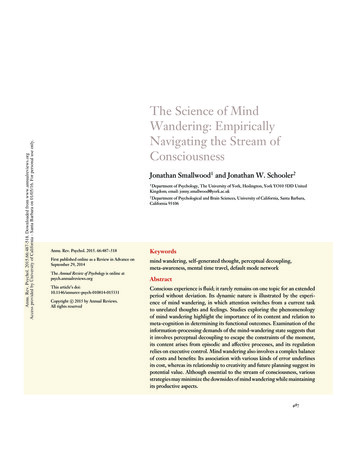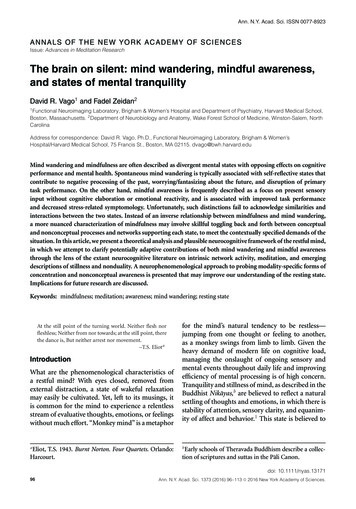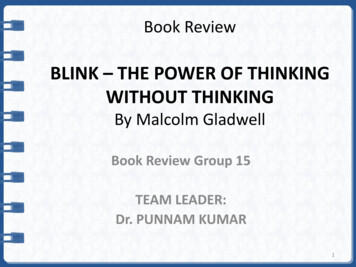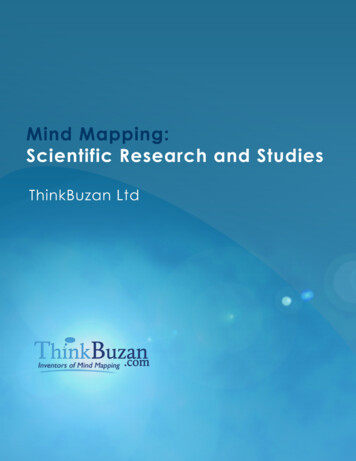
Transcription
PS66CH19-SmallwoodARIANNUALREVIEWS12 November 201415:19FurtherAnnu. Rev. Psychol. 2015.66:487-518. Downloaded from www.annualreviews.orgAccess provided by University of California - Santa Barbara on 01/05/16. For personal use only.Click here for quick links toAnnual Reviews content online,including: Other articles in this volume Top cited articles Top downloaded articles Our comprehensive searchThe Science of MindWandering: EmpiricallyNavigating the Stream ofConsciousnessJonathan Smallwood1 and Jonathan W. Schooler21Department of Psychology, The University of York, Heslington, York YO10 5DD UnitedKingdom; email: jonny.smallwood@york.ac.uk2Department of Psychological and Brain Sciences, University of California, Santa Barbara,California 93106Annu. Rev. Psychol. 2015. 66:487–518KeywordsFirst published online as a Review in Advance onSeptember 29, 2014mind wandering, self-generated thought, perceptual decoupling,meta-awareness, mental time travel, default mode networkThe Annual Review of Psychology is online atpsych.annualreviews.orgThis article’s doi:10.1146/annurev-psych-010814-015331c 2015 by Annual Reviews.Copyright All rights reservedAbstractConscious experience is fluid; it rarely remains on one topic for an extendedperiod without deviation. Its dynamic nature is illustrated by the experience of mind wandering, in which attention switches from a current taskto unrelated thoughts and feelings. Studies exploring the phenomenologyof mind wandering highlight the importance of its content and relation tometa-cognition in determining its functional outcomes. Examination of theinformation-processing demands of the mind-wandering state suggests thatit involves perceptual decoupling to escape the constraints of the moment,its content arises from episodic and affective processes, and its regulationrelies on executive control. Mind wandering also involves a complex balanceof costs and benefits: Its association with various kinds of error underlinesits cost, whereas its relationship to creativity and future planning suggest itspotential value. Although essential to the stream of consciousness, variousstrategies may minimize the downsides of mind wandering while maintainingits productive aspects.487
PS66CH19-SmallwoodARI12 November 201415:19ContentsAnnu. Rev. Psychol. 2015.66:487-518. Downloaded from www.annualreviews.orgAccess provided by University of California - Santa Barbara on 01/05/16. For personal use only.INTRODUCTION . . . . . . . . . . . . . . . . . . . . . . . . . . . . . . . . . . . . . . . . . . . . . . . . . . . . . . . . . . . . . . .TERMINOLOGY, MEASUREMENT, AND CONCEPTUAL ISSUES . . . . . . . . . . .Terminology . . . . . . . . . . . . . . . . . . . . . . . . . . . . . . . . . . . . . . . . . . . . . . . . . . . . . . . . . . . . . . . . . . .Measurement . . . . . . . . . . . . . . . . . . . . . . . . . . . . . . . . . . . . . . . . . . . . . . . . . . . . . . . . . . . . . . . . . . .Conceptual Issues . . . . . . . . . . . . . . . . . . . . . . . . . . . . . . . . . . . . . . . . . . . . . . . . . . . . . . . . . . . . . .PHENOMENOLOGY. . . . . . . . . . . . . . . . . . . . . . . . . . . . . . . . . . . . . . . . . . . . . . . . . . . . . . . . . . . .The Content of Self-Generated Thought . . . . . . . . . . . . . . . . . . . . . . . . . . . . . . . . . . . . . . . .Relation to Awareness . . . . . . . . . . . . . . . . . . . . . . . . . . . . . . . . . . . . . . . . . . . . . . . . . . . . . . . . . .THE COMPONENT PROCESS VIEW . . . . . . . . . . . . . . . . . . . . . . . . . . . . . . . . . . . . . . . . . .How Higher Cognition Becomes Disengaged from External Processing . . . . . . . . . . .How People Self-Generate Mental Content Unrelated to Their Environment . . . . .How Disengagement and Self-Generation are Coordinated and/or Regulated . . . . .Open Questions . . . . . . . . . . . . . . . . . . . . . . . . . . . . . . . . . . . . . . . . . . . . . . . . . . . . . . . . . . . . . . . .COSTS AND BENEFITS OF THE MIND-WANDERING STATE . . . . . . . . . . . . . .Mind Wandering and Ongoing Performance . . . . . . . . . . . . . . . . . . . . . . . . . . . . . . . . . . . . .The Benefits of a Wandering Mind . . . . . . . . . . . . . . . . . . . . . . . . . . . . . . . . . . . . . . . . . . . . . .MIND WANDERING IN DAILY LIFE . . . . . . . . . . . . . . . . . . . . . . . . . . . . . . . . . . . . . . . . . .TECHNIQUES FOR MINIMIZING THE DISRUPTING EFFECTSOF MIND WANDERING . . . . . . . . . . . . . . . . . . . . . . . . . . . . . . . . . . . . . . . . . . . . . . . . . . . . .Mindfulness Training . . . . . . . . . . . . . . . . . . . . . . . . . . . . . . . . . . . . . . . . . . . . . . . . . . . . . . . . . . .Meta-Awareness . . . . . . . . . . . . . . . . . . . . . . . . . . . . . . . . . . . . . . . . . . . . . . . . . . . . . . . . . . . . . . . .Task Engagement . . . . . . . . . . . . . . . . . . . . . . . . . . . . . . . . . . . . . . . . . . . . . . . . . . . . . . . . . . . . . .CONCLUDING REMARKS . . . . . . . . . . . . . . . . . . . . . . . . . . . . . . . . . . . . . . . . . . . . . . . . . . . . 08509509509509509INTRODUCTIONMind wandering:a shift in the contentsof thought away froman ongoing task and/orfrom events in theexternal environmentto self-generatedthoughts and feelings488Experience is not always tethered to the here and now; instead, it ebbs and flows between mentalcontents from both intrinsic and extrinsic sources. Although there is a long tradition of research onhow attention shifts between external sources (e.g., Desimone & Duncan 1995, Posner & Petersen1990, Treisman & Gelade 1980), science has only recently taken aim at understanding how themind shifts between external events and internal thoughts and feelings unrelated to the goings onaround it. Following the seminal work of Singer, Klinger, and Antrobus on daydreaming in thelate 1960s and early 1970s (Antrobus et al. 1966, Klinger 1966), a handful of researchers exploredthe psychological processes underpinning the mind’s capacity to stray from external events andto generate thoughts with no referent in the environment (Giambra 1989, Teasdale et al. 1995).However, only in the past decade has widespread scientific attention been given to the topic ofmind wandering (Smallwood & Schooler 2006).A confluence of factors have contributed to the suitability of mind wandering as a focus ofresearch (Callard et al. 2013, Forster 2013, Gilbert et al. 2007, Gruberger et al. 2011, Kane &McVay 2012, Killeen 2013, Marchetti et al. 2012, Mooneyham & Schooler 2013, Schooler et al.2011, Smallwood 2013a, Smallwood & Schooler 2006). Unquestionably, this issue has been thebeneficiary of a change in the scientific zeitgeist regarding the appropriateness of the study of consciousness. The field of psychology was slow to shed the skepticism toward internal experiencethat it inherited from the behaviorist era (Callard et al. 2012, Cohen & Schooler 1997). However,Smallwood·Schooler
Annu. Rev. Psychol. 2015.66:487-518. Downloaded from www.annualreviews.orgAccess provided by University of California - Santa Barbara on 01/05/16. For personal use only.PS66CH19-SmallwoodARI12 November 201415:19as scientific consideration of consciousness became more accepted, so too did the investigation ofmind wandering. Closely allied with this shift were methodological advances in the study of consciousness. As we discuss below, the stream of consciousness is being increasingly illuminated bythe strategy of triangulation, whereby self-report, behavioral measures, and neurocognitive measures are used together to make inferences about underlying mental states (Schooler & Schreiber2004, Varela & Thompson 2003).Research on mind wandering undoubtedly has also been advanced by research in cognitiveneuroscience, and in particular the development of functional magnetic resonance imaging (fMRI)(Ogawa et al. 1990). The spatial resolution offered by fMRI has meant that it has swiftly becomea primary tool for investigating the inner workings of the mind, a technique that is at its mostadvantageous when focused on private experiences such as mind wandering. Moreover, in theearly years of this century a network of brain regions focused on the medial surface of the cortexand known as the default mode network was discovered (Greicius et al. 2003, Raichle et al. 2001).This network is active when participants engage in the sort of thinking that occurs during mindwandering, such as thoughts about the future, of themselves, or of other people (Andrews-Hannaet al. 2014), and it was swiftly linked to the mind-wandering state (Mason et al. 2007; McKiernanet al. 2003, 2006). The discovery of this network and its experiential correlates provided a viablestarting point from which to understand the brain basis of mind wandering.Finally, it has become apparent that neurocognitive processes that are not constrained byexternal input are ubiquitous aspects of the human condition. Unconstrained neural processing,such as that which occurs during the resting state, is common to all known brain networks, whichraises important questions on how to interpret task-free activity (Buckner & Vincent 2007, Smithet al. 2009). Moreover, studies indicate that people spend somewhere between 25% and 50%of their waking hours engaged in thoughts unrelated to the here and now (Kane et al. 2007,Killingsworth & Gilbert 2010). Unconstrained mental processes are the norm rather than theexception for our species, and mind wandering provides a clear paradigm in which to understandtheir psychological features.Happily, the gap is closing between the regularity with which people mind wander and thefrequency with which scientists study it. The past decade has witnessed an explosion of developments in understanding how, when, and why the mind wanders. This review describes the methodsthat have been established to understand mind wandering, examines its phenomenology and theneurocognitive processes that it entails, and considers the costs and benefits that this experiencecan bring. Before considering these issues in detail, the conceptual and empirical challenges thatunderstanding the wandering mind entails are described.Triangulation:a procedure forinferring internalmental processes basedon a combination ofself-reports andphysiological andbehavioral measuresDefault modenetwork: a networkof brain regionsinvolving the medialsurface of the cortexthat is engaged by thesort of thinking thatoccurs during mindwandering (e.g., thefuture, the self, otherpeople) and is activeduring periods of mindwanderingSelf-generatedthought: the capacityfor a person togenerate mentalcontents that are notderived directly fromimmediate perceptualinputTERMINOLOGY, MEASUREMENT, AND CONCEPTUAL ISSUESTerminologyWhen the mind wanders, attention drifts from its current train of thought (often an external task)to mental content generated by the individual rather than cued by the environment. Often thethoughts that occur during mind-wandering experiences are described as task unrelated (Giambra1989) or stimulus independent (Antrobus et al. 1966), terms that capture the independence of theexperiences from perception and ongoing actions. Other terms, such as autobiographical thoughtor mind pops (Kvavilashvili & Mandler 2004), capture the generative process that provides thecontent of the experience itself. One term that captures the generative aspects of these experiencesas well as their independence from perception is self-generated thought (Smallwood 2013a,b). Thewww.annualreviews.org Mind Wandering489
PS66CH19-SmallwoodARI12 November 201415:19Annu. Rev. Psychol. 2015.66:487-518. Downloaded from www.annualreviews.orgAccess provided by University of California - Santa Barbara on 01/05/16. For personal use only.SELF-GENERATED THOUGHTSelf-generation describes how an experience arises rather than its relation to intention. The term self-generatedthought emphasizes that the contents of experience arise from intrinsic changes that occur within an individualrather than extrinsic changes that are cued directly from perceptual events occurring in the external environment.These experiences can occur intentionally, such as when we consider the solution to a work-related problem on thejourney to work, or they can also occur unintentionally, such as when our mind wanders while reading.Self-generated thought can be task related as well as task unrelated. In cognitive science, the term task is oftenconfounded with external action. However, many tasks do not depend upon current perceptual input or lead toimmediate behavior. Tasks such as deciding where to go for brunch on the weekend, or what journal to send ascientific manuscript to, can be performed reasonably well using imagination alone. These are examples of taskrelated self-generated thought. Self-generated thought can also be task unrelated when its occurrence coincideswith the performance of an alternative task, such as during vigilance or while driving an automobile or reading.These are examples of task-unrelated self-generated thought.The independence of self-generated thought from the term task relatedness is important because it allows formind-wandering episodes to contain both strategic/deliberate and spontaneous/unintentional elements, a distinctionthat may be important in its experiential qualities (see section on Phenomenology) and in distinguishing the positiveand negative elements of mind wandering (see section on Costs and Benefits). Figure 1 illustrates the ways in whichself-generated thought and task-related thought are independent constructs.Self-generated thoughts are distinct from external distraction. When occurring during an unrelated task, selfgenerated thought is a well-documented cause of error. However, studies have shown that these errors can be distinctfrom those based on external distraction. For example, the individuals whose minds wander the most exhibit theleast neural processing of distractors (Barron et al. 2011) (although see Forster & Lavie 2014) and are the leastimpacted by orienting cues (Hu et al. 2012); distracter events are processed most strongly when people are on task(Esterman et al. 2014). Similarly, studies of individual differences suggest cognitive control makes partially distinctcontributions to internal and external distraction (Stawarczyk et al. 2014, Unsworth & McMillan 2014). One reasonwhy task-unrelated self-generated thought and external distraction are distinct is that the former depends on theprocess of perceptual decoupling whereas the latter does not (see Component Processes section). Figure 1 illustrateshow self-generation of thought is distinct from external distraction.conceptual basis of self-generated thought and its distinction from both task-unrelated thoughtand external distraction are described in Figure 1 (see also sidebar Self-Generated Thought).MeasurementExperience sampling(ES): a methodologyfor assessing ongoingthoughts in whichparticipants areperiodically asked toreport what they arecurrently thinkingabout490Investigations of mind wandering use the technique of experience sampling (ES) (Kahneman et al.2004) to capture moments when we are conscious of intrinsic or extrinsic input (see sidebar Experience Sampling: A Tool for Measuring the Wandering Mind). Despite researchers’ interestsin the wandering that leads our thoughts to stray from the moment, the experimental measurement usually corresponds to the contents of conscious experience at particular moments in time.Although it is safe to assume that dynamic changes must have led to the current mental state, theES approach does not enable researchers to watch in real time as conscious states evolve fromone mental state to the next. This is one reason why an important avenue in research on mindwandering is the pursuit of indirect measures of the experience.Smallwood·Schooler
PS66CH19-SmallwoodARI12 November 201415:19Perceptually guidedRelated to the task7, 2, 4, 8.Self-generatedAnnu. Rev. Psychol. 2015.66:487-518. Downloaded from www.annualreviews.orgAccess provided by University of California - Santa Barbara on 01/05/16. For personal use only.Task focusUnrelated to the taskIs that myphone?DistractedGRR !?!?!What is the pointof this task?Self-generated task relatedSelf-generated task unrelatedFigure 1A schematic of the relationship between the focus of cognition (task-related) and self-generated thought.The term self-generated thought is not specific to states of mind wandering; instead, it refers to processesinvolved in producing mental contents that are not primarily driven by the external environment. Forexample, in the top left panel the participant is fully focused on the task such that the contents of thought areonly those that arise from sensory input. However, in the bottom left panel the thoughts of the participantare related to the task but are also self-generated because the task stimulus in of itself does not necessitate thethought. This would be an example of task-related self-generated thought. Self-generated thought is notalways a property of thoughts that are unrelated to the task in hand. For example, in the top right panel theparticipant is distracted by a noise in the environment and so becomes temporarily disengaged from the taskshe is performing. However, this external distraction arises due to perceptual input, not through theself-generation of mental contents. Finally, in the bottom right panel the participant has disengaged attentionfrom the task in hand and has begun to self-generate thoughts regarding her upcoming beach holiday.Conceptual IssuesIt is standard to investigate the basis of cognitive functions through the experimental manipulation of the process in question. Usually an imperative stimulus is presented to participants andtheir response (behavioral, neural, or psychological) is recorded. By varying the nature of thestimulus or the task that participants perform and observing any changes that occur, inferencescan be drawn on the nature of the underlying mental processes (Donders 1969). Mind-wanderingepisodes depend to a large extent on processes that are spontaneous rather than those induceddirectly by the experimenter (Smallwood 2013a), and these changes have few directly observableconsequences. The experimental investigation of mind wandering, therefore, poses a number ofspecific challenges that must be overcome in order to measure and assess mind wandering in ascientific manner.One challenge arises because researchers lack the ability to directly cause the mind to wander.Instead, the spontaneous occurrence of mind wandering means that the causal path that links theexperience to ongoing processes and outcomes is opaque. For example, evidence suggests that poorwww.annualreviews.org Mind Wandering491
PS66CH19-SmallwoodARI12 November 201415:19EXPERIENCE SAMPLING: A TOOL FOR MEASURING THE WANDERING MINDAnnu. Rev. Psychol. 2015.66:487-518. Downloaded from www.annualreviews.orgAccess provided by University of California - Santa Barbara on 01/05/16. For personal use only.Experience sampling (ES) refers to the collection of self-reports regarding a participant’s ongoing experience(Kahneman et al. 2004). There are a number of different methods of ES.1. Probe-caught method. The most common ES method is to acquire data using a sampling regime known as theprobe-caught method (Smallwood & Schooler 2006). Participants are intermittently interrupted and probedregarding the contents of their experience. These occur in a random or quasi-random manner, although studieshave used sampling regimes based on changes in performance (such as reading times; Franklin et al. 2011). Oneimportant issue is the duration between online ES probes, with studies showing greater reports of off-task thoughtwith larger gaps between probes (Seli et al. 2013, Smallwood et al. 2002).2. Self-caught method. Participants are asked to spontaneously provide ES reports, such as reporting when they catchtheir mind wandering (Smallwood & Schooler 2006). In combination with the probe-caught method, this mayallow the estimation of the capacity of participants to reflect upon their conscious experience (Schooler et al. 2011).3. Retrospective method. ES data are gathered at the end of a task via questionnaires, preserving the natural timecourse of the task (Barron et al. 2011, Smallwood et al. 2012). This can be important for certain covert measures(such as resting state fMRI). One limitation in the retrospective measure is that it can be confounded withindividual differences unless multiple measurements are recorded within the same individual (e.g., Gorgolewskiet al. 2014).4. Open-ended method. ES data can also be gathered by asking participants to describe in their own words whatthey experienced during a task (Baird et al. 2011). This method has the advantage of not imposing categoriesthat constrain participants’ reports.Triangulation between different techniques will be important to allow an account of mind wandering that is nottied to a specific method. For example, probe-caught (Franklin et al. 2013a, Kam et al. 2011, Smallwood et al.2011a) and retrospective methods (Barron et al. 2011, Smallwood et al. 2012) reveal similar changes in pupildilation and EEG, which suggests that certain results will be conserved across ES methodologies.executive control leads to greater mind wandering during demanding tasks (McVay & Kane 2009,2011). However, mind wandering in the context of executive control tasks has a negative influenceon performance (Mrazek et al. 2012a). It is thus unclear whether low executive control causesgreater mind wandering, or greater mind wandering during span tasks causes lower estimationsof control.The covert nature of mind wandering creates a second challenge to its investigation. Unlike perceptual guided thought that can be assessed directly through its contributions to action,self-generated experiences are fundamentally internal, with few external manifestations. Currentunderstanding of the mind-wandering state depends on the experimenter’s capacity to sample experience in an effective and nonbiased manner (see Experience Sampling sidebar for a descriptionof the different ES approaches that can be used to study mind wandering).A third challenge arises because assessment of mind wandering typically depends on selfreport. A reliance on introspection means that studies of mind wandering need to be corroboratedby external measures to ensure that the results are not simply a consequence of the limitationsof self-report (Schooler & Schreiber 2004) or the concern that they may indirectly change thequality of the experience (Smallwood & Schooler 2006).Therefore, at least three conceptual issues arise in the investigation of mind wandering:(a) the lack of direct experimental control, (b) the covert nature of self-generated thoughts, and(c) the validity and potential reactivity of introspective evidence. Over the past decade, advances492Smallwood·Schooler
PS66CH19-SmallwoodARI12 November 201415:19Annu. Rev. Psychol. 2015.66:487-518. Downloaded from www.annualreviews.orgAccess provided by University of California - Santa Barbara on 01/05/16. For personal use only.in the field of mind wandering have facilitated progress on these issues, and Figure 2 provides aschematic account of how these different techniques might be employed in a laboratory study.Lack of direct experimental control. Although mind wandering cannot be induced as preciselyas can external task performance, various manipulations can influence its occurrence. Forexample, mind wandering is closely linked to unhappiness (Smallwood et al. 2007b), and theexperimental induction of negative affect can increase the occurrence of mind wandering (V.Engert, J. Smallwood & T. Singer, manuscript under review; Smallwood et al. 2009a; Smallwood& O’Connor 2011; Vinski & Watter 2013) (see top left panel in Figure 2). Other work has foundthat states of craving, or intoxication through alcohol, increase mind wandering (Sayette et al.2010, 2012). Finally, studies have documented that engaging in meditative practice can help toreduce the mind’s tendency to wander (Morrison et al. 2013, Mrazek et al. 2013a).It is also possible to manipulate mind wandering by varying the demands of an ongoing taskwith respect to controlled processing (Mason et al. 2007, Teasdale et al. 1995), perceptual input(Forster & Lavie 2009, Levinson et al. 2012), or motivation (Antrobus et al. 1966, Smallwoodet al. 2007b). One common approach is to vary between a choice reaction time task and a workingmemory task (e.g., Smallwood et al. 2009b). In these two paradigms, perceptual input is constant;however, the working memory task requires participants to continually encode and maintain thisstimulus, whereas this is not necessary in the choice reaction time task. As a result, task-unrelatedthought is more common in the choice reaction time task (for an example, see top right panel inFigure 2).Thus, although mind wandering cannot be directly induced, by altering a person’s psychologicalstate or varying the complexity of an ongoing task it is possible to gain some degree of experimentalcontrol over the experience. These manipulations are critical in understanding the nature of thewandering mind because they provide boundary conditions that inform our understanding of thefunctions of the state.The covert nature of the mind-wandering state. To measure mind wandering, researchers employ ES to document when and under what conditions the experience occurred. These approachesare invaluable in illuminating the content of the experiences themselves; however, because theyare subjective they are also difficult to verify objectively. One solution is to combine subjectiveand objective indices of cognitive function in order to identify the variance common to both, aprocess referred to as triangulation (Schooler & Schreiber 2004).Studies have found that variability is characteristic of the mind-wandering state in termsof both response times (Carriere et al. 2008; Cheyne et al. 2006, 2011; McVay & Kane 2009)and physical posture (Carriere et al. 2013, Seli et al. 2014). Mind wandering is also associatedwith divergent eye movements (Foulsham et al. 2013, Reichle et al. 2010), greater pupil dilation(Franklin et al. 2013a; Smallwood et al. 2011b, 2012), more frequent eye blinks (Smilek et al.2010), and changes in electroencephalography (EEG) readings (Baird et al. 2014, Barron et al.2011, Kam et al. 2011, Smallwood et al. 2008a) and in the blood-oxygen-level dependent (BOLD)signal as recorded during fMRI (Allen et al. 2013, Christoff et al. 2009, Stawarczyk et al. 2011a).At the neural level, multivoxel pattern analysis has been able to predict subjective reports ofthe content of thought at rest on the basis of task-based examples of the same types of thought(Tusche et al. 2014). These covert markers validate the subjective measures and allow differentcognitive and neural accounts of the mind-wandering experience to be tested. They also raisethe possibility that indirect markers for mind wandering could ultimately be used to detect itsoccurrence without interrupting study participants.www.annualreviews.org Mind Wandering493
PS66CH19-SmallwoodARI12 November 201415:19The influence of measurement on the mind-wandering state. Although ES is an invaluabletool for studying mind wandering, it also carries the risk that introspection changes the nature of thestate that is being assessed (Schooler 2002a). Online ES alerts the participant to the key dependentmeasure of the experiment, and by periodically disrupting the ongoing task disrupts the naturaldynamics of both task performance and of the experience itself. Finally, because introspection hasInductionphaseaVariable taskdemandsTask phaseTask-unrelatedthought (%)Annu. Rev. Psychol. 2015.66:487-518. Downloaded from www.annualreviews.orgAccess provided by University of California - Santa Barbara on 01/05/16. For personal use only.0.80.60.40.20.0EasyHardTask t thenwas yourattentionon task?OnlineMRI1.00Pupil dilationn 205CorrectIncorrect0.750.50n 01Time (s)Pupil dilation494Smallwood·Schooler2Retrospective
PS66CH19-SmallwoodARI12 November 201415:19Annu. Rev. Psychol. 2015.66:487-518. Downloaded from www.annualreviews.orgAccess provided by University of California - Santa Barbara on 01/05/16. For personal use only.the potential to change the psychological meaning of an event, ES could alter the quality of theexperience itself.One solution is to acquire self-report data after participants have completed an experimentalsession. Although this measure necessarily depends on memory, it allows the collection of datawithout artificial disruptions and is useful because by preserving the integrity of time-course data, itallows temporal properties in objective measures to be related to ES data. Retrospective indicatorsof self-generated thought have been related to the dynamic changes that occur in the time-seriesdata derived from pupillometry (Smallwood et al. 2012), EEG (Barron et al. 2011), and the BOLDsignal during the resting state (Gorgolewski et al. 2014).Meta-awareness: themental state that ariseswhen attention isdirected towardexplicitly noting thecurrent contents ofconsciousness, e.g.,realizing that one’smind is wanderingPHENOMENOLOGYResearch over the past 15 years has made progress in understanding the phenomenological aspectsof mind wandering. Studies have explored the form and content of the self-generated thoughts thatoccur during mind wandering and have found that they are often an eclectic mixture of thoughtsregarding the future and memories from the past, usually with personal relevance. Research hasalso focused on the relationship between mind wandering and meta-awareness (Schooler 2002a);i.e., an individual’s
mind wandering. Closely allied with this shift were methodological advances in the study of con-sciousness. As we discuss below, the stream of consciousness is being increasingly illuminated by the strategy of trian










